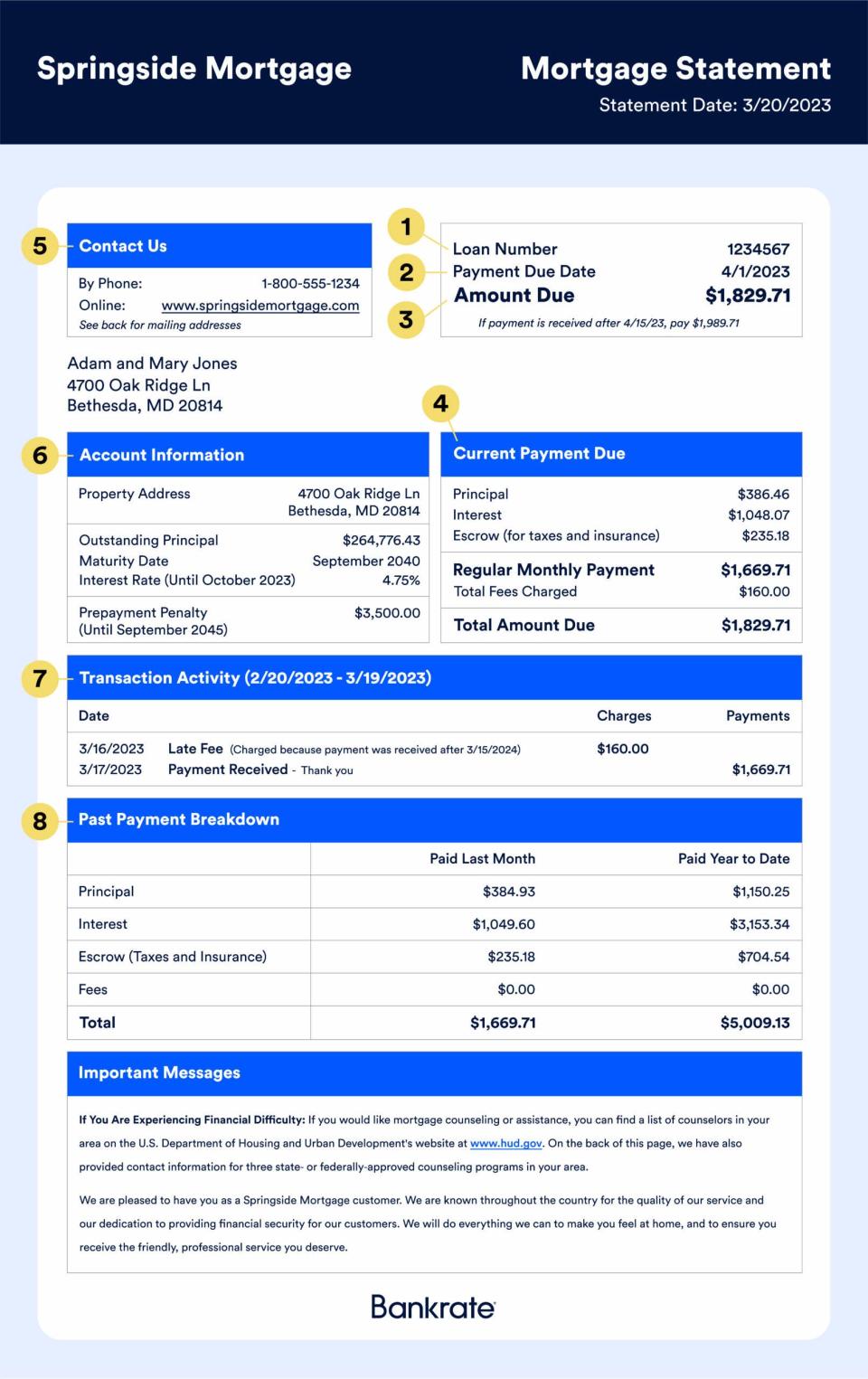
Key takeaways
-
Your mortgage statement is a document that includes key details about your loan.
-
You’ll receive a statement from your lender or servicer for each billing cycle, and it’s a good idea to review every statement for accuracy.
-
If you can access your statements online, you might decide to get rid of the paper versions — but there are some documents you should never throw out.
-
When it’s time to pay your mortgage, you can do so in many ways, such as auto-pay, online or by mail.
Your mortgage statement has important details about your loan balance and payments. You should receive a statement each month from your mortgage servicer. Here, we’ll tell you what a mortgage statement looks like, so you’ll know exactly what to expect every month.
What is a mortgage statement?
A mortgage statement is a document containing the latest details about your loan, including your monthly payment. The law requires your mortgage lender or servicer to send you statements for each billing cycle.
Mortgage statements are typically issued once a month via mail. You can also find them on your lender’s or servicer’s website. You might be able to receive them electronically, but it may be easier to spot any errors on a hard copy versus an electronic copy.
What does a mortgage statement look like?
Part of what’s included in your mortgage statement is your outstanding loan balance and the loan’s maturity date—or when you’ll fully repay the loan. The statement will also include a breakdown of part of your payment history.
Your monthly mortgage statement contains a comprehensive overview of your loan and the progress you’re making in paying it off. But if you’re curious about what a mortgage statement looks like, here’s an example:
Understanding the details on a mortgage statement
-
Account/loan number: This is the number associated with your loan. You might see it displayed when you log into your servicer’s website. If you contact your servicer for any reason, you’ll need to provide this number.
-
Payment due date: Most mortgage payments are due on the first of the month. If you’re set up with auto-payments, this due date serves as a reminder of when those funds come out of your bank account. If you’re paying by mail, be sure to send it several days before the due date to ensure it arrives on time. However, servicers typically respect a two-week grace period before charging you a late fee.
-
Amount due: This is the full payment due on the due date, including principal, interest, escrow and any fees.
-
Current payment due: This section itemizes your monthly payment so you can see exactly how much you’re paying toward the principal, interest, escrow and any fees.
-
Contact us: Here, you’ll find various ways to contact your servicer, such as its phone number and website.
-
Account information: This section typically includes your contact information, the balance left on your loan, your interest rate and when your loan term ends (known as the “maturity date”). It might also indicate a prepayment penalty, which is a fee your servicer will charge if you pay off your loan early. Most mortgages today don’t impose a prepayment penalty.
-
Transaction activity: This section provides dates and descriptions of the activities in your account from the last month, including when payments were received. You may also get notices of late payment fees and how much they cost here.
-
Past payment breakdown: This section presents your payment history from the last month, as well as so far for the year (“year to date”).
How long should you keep your mortgage statement?
Some borrowers keep their mortgage statements for up to three years, but because you can access them online through your servicer’s website, it’s fine to shred them at any time. You might want to access them later if you want to see how much your property taxes and home insurance costs have changed over time or to verify your transaction history for a particular month.
However, while you can discard your mortgage statements, don’t ever get rid of:
-
Closing documents, including the mortgage note and title information
-
Form 1098, the IRS loan interest document you’ll need when it comes time to file
-
Appraisal documents
-
Home inspection and any home warranty documents
-
Property survey
You should keep and store these documents in a fire-safe place for the entire time you own the property, even after you pay off your mortgage.
Separate from your mortgage statements, you’ll also receive an annual escrow account statement. This statement contains estimated escrow payments, so hang onto it — it helps you understand whether your account might have a shortfall or if you’ve overpaid. Another pro tip: Compare the property taxes paid on the statement versus what the tax collector indicates was paid on its website. Sometimes, there can be discrepancies if your servicer changes.
How to use your mortgage statement
If you’ve been paying your mortgage for a while, you might be tempted to give your monthly statement a brief look, make your payment and dispose of it. But these documents provide valuable information about your loan. Next time you receive a statement, take the time to carefully review the following for accuracy:
Unless you have an adjustable-rate mortgage (ARM), your interest rate should stay the same. If you do have an ARM, your statement shows how long your current rate is in effect.
The balance or outstanding principal, however, changes as you pay down the loan. You can use this information to help guide decisions around accessing your home’s equity, refinancing or selling your home.
If you don’t auto-pay your mortgage, keep an eye out for any late fees listed on your statement, too. Most lenders allow a 15-day grace period before they charge a late fee.
In addition, review the escrow payments. These go to an escrow account that covers your homeowners insurance premiums and property taxes. Since premiums and taxes can fluctuate year to year, your monthly payment might go up or down (likely up) over time.
If you’re behind on your mortgage payments by 45 days or longer, your statement will also include a “delinquency notice.” If this is the case, contact your servicer right away to explore relief options.
How to pay your monthly mortgage payment
You can pay your mortgage by setting up auto-payments, paying through your servicer’s online portal or mailing the payment with enough time for it to arrive before the due date. You can also charge your mortgage payment to a credit card, but keep in mind that not many lenders or servicers allow this. Other payment options include paying the bill over the phone or in person at a local branch, if possible. Your mortgage statement will often indicate the payment methods your servicer accepts.
Need guidance on how to get a current mortgage statement to review your loan details? Log in to your online account or reach out to your lender or servicer.







